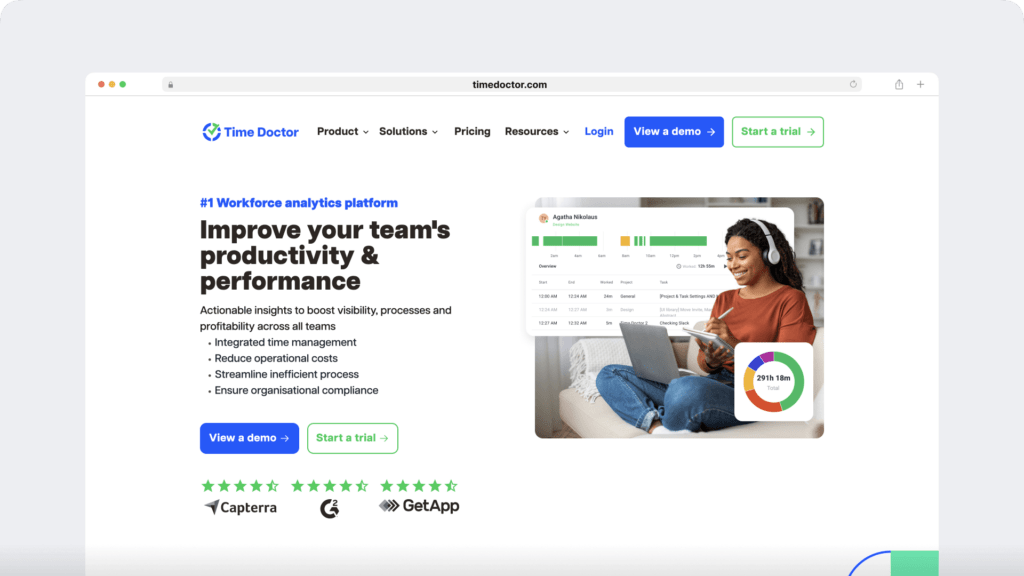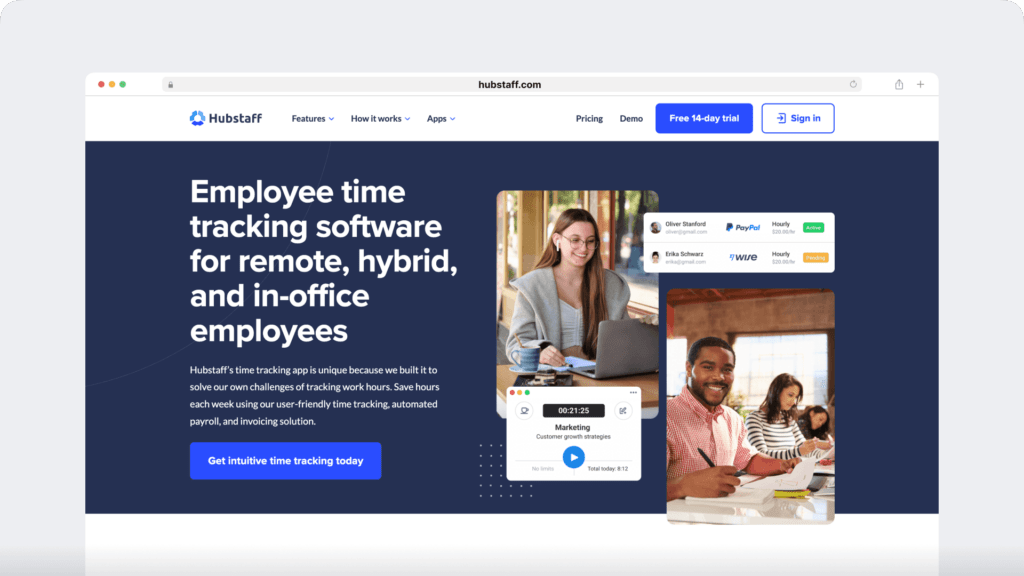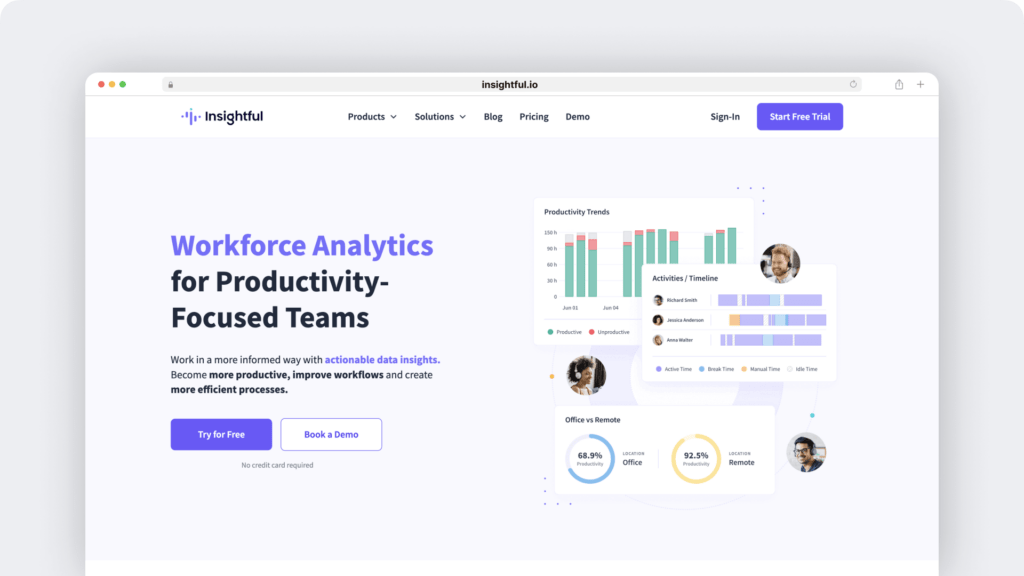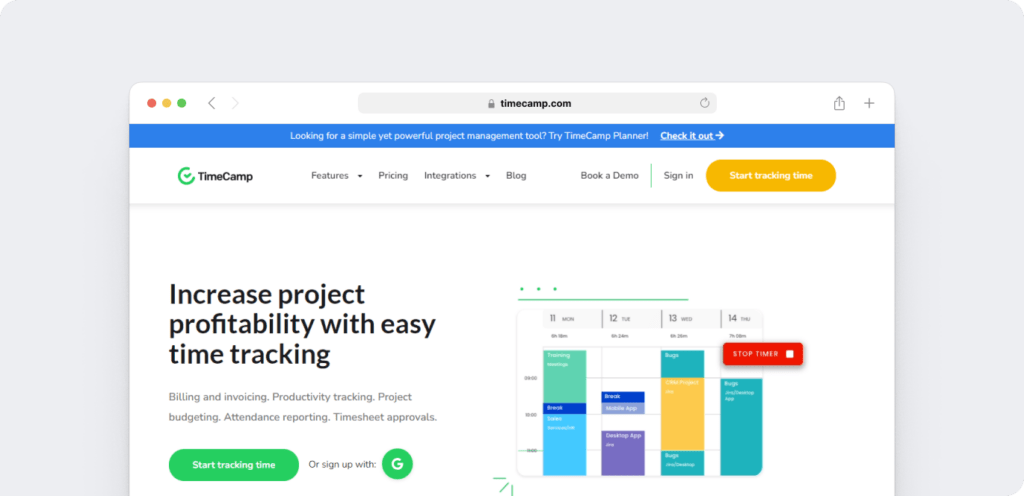How do you keep track of your team’s productivity when they’re not in the office anymore?
When the pandemic hit, companies had to adapt almost overnight. Office routines disappeared. Desks went empty. Suddenly, your team was working from bedrooms, kitchen tables, and sometimes even cars.
That shift made one thing very clear. Remote work time tracking is no longer optional. Instead of relying on hallway check-ins or quick glances at someone’s screen, you now need reliable ways to see who’s working, when they’re available, and what they’re focused on.
At the same time, remote workers want to feel trusted. Managers need real-time insights without creating pressure. And distributed teams want flexibility while staying aligned. These needs often pull in different directions, which makes it harder to create a system that works for everyone.
This guide will help you bridge the gap. You’ll learn what to track, what to avoid, and how to use employee time tracking tools that support productivity, privacy, ease of use, and performance all at once.
Table of Contents
9 benefits of remote work time tracking
When implemented thoughtfully, time tracking provides significant benefits for both managers and employees. Here’s how:
1. Boosts productivity and focus
When employees see where their time goes, they naturally become more aware of how they work. Tracking tools highlight time spent on apps, websites, or tasks. For example, if someone sees they spent 3 hours switching between tabs, it’s a cue to refocus. This insight leads to fewer distractions and better use of work hours.
2. Improves accountability without micromanaging
Employee monitoring software with built-in activity tracking displays when tasks begin, pause, and end, enabling teams to stay accountable without micromanagement.
Managers can monitor employee activity without constant check-ins or Slack messages. The result is simple. People take more ownership of their schedules because they understand what is being tracked and why. This creates trust and autonomy.
3. Identifies idle time and workflow issues
Every team hits bottlenecks. A designer may wait hours for approvals, or a developer may be unable to access their work. Time tracking software helps identify patterns in idle time, allowing you to intervene early.
Real-time activity views and app usage reports make it easier to identify and remove blockers, improving team management before delays occur.
4. Enhances time management and project planning
Knowing how long tasks take helps your team plan better. Let’s say your marketing team logs more hours on content writing than expected. That suggests adjusting deadlines or allocating more support. Tools with built-in timesheets, productivity analytics, and smart tracking features transform time data into more informed project management decisions.
5. Improves visibility across time zones
When your team works across different time zones, staying in sync can be a challenge. You may not need to monitor every minute, but visibility is crucial.
Using remote work time tracking tools helps you see who is active and when. This improves coordination, reduces confusion, and keeps everyone aligned. It also makes it easier to manage schedules, avoid missed handovers, and set clear expectations.
6. Supports data-driven performance reviews
Performance shouldn’t rely on guesswork. Instead of vague feedback, managers can use productivity reports, app usage logs, and task completion data to discuss actual outcomes. For example, if a team member consistently delivers ahead of time, that’s performance you can recognize and reward.
7. Helps prevent burnout
Many remote employees feel pressure to be online at all times. Tracking total work hours, including breaks and idle time, helps managers see when someone is overloaded. You might notice someone working 12-hour days every week. That’s your sign to check in and help adjust their workload before burnout sets in.
8. Simplifies workforce management
Whether you run a startup or lead a large, distributed workforce, time tracking software gives you a single source of truth. From payroll to attendance, everything’s easier when work data is in one place. You can track time, pull timesheets, and manage your team without juggling spreadsheets.
9. Builds transparency into your work environment
Remote work thrives on trust. When time tracking is handled openly, your team understands what’s expected and how their time contributes to team productivity and results.
It’s not about spying. Instead, it’s about creating clarity. The right monitoring tools help everyone stay informed, aligned, and focused.
What are the common challenges in remote time tracking?
Remote time tracking is helpful, but it’s not always smooth. When used improperly, even the best tools can create stress, confusion, or mistrust. To keep your team focused and productive, it’s essential to avoid these common mistakes.
Here are five challenges businesses face when tracking time remotely, along with solutions to address them.
1. Lack of visibility and trust
When everyone works remotely, it becomes harder for managers to track progress. Without regular face-to-face interaction, some leaders start to question whether people are staying engaged. As a result, they may over-monitor or expect team members to be online at all times.
To build trust, track outcomes rather than just online activity. Utilize remote work time tracking tools that display the progress of tasks. When employees feel supported instead of watched, they are more likely to stay motivated and productive.
2. Time zone confusion
Working across different time zones makes it difficult to align schedules. Without a clear system for coordinating time, teams may face missed meetings, delayed handovers, or unbalanced workloads.
One way to solve this is by using employee time tracking software that highlights team availability and supports flexible hours.
Define shared collaboration times and allow everyone to manage the rest of their schedule independently to optimize work-life balance. This helps prevent burnout and creates a more balanced workflow.
3. Concerns around keystroke logging and webcam use
Some time tracking tools include features like screenshot capture, webcam monitoring, and keystroke tracking. Although these features are designed to increase visibility, they can make employees feel uncomfortable or as though they are being micromanaged.
Instead of using surveillance-heavy tools, choose a time tracker that focuses on work progress and productivity. Be clear about what is being monitored and why. A respectful and transparent setup promotes trust and fosters better engagement.
4. Burnout from over-monitoring
Tracking every minute may seem efficient at first. However, it can quickly lead to stress if team members feel like they’re being observed too closely. Employees might avoid taking breaks or feel anxious about stepping away from their desks.
To prevent this, allow room for flexibility. Let your time tracking system encourage balance, not control. Support break times and reasonable hours. This shows your team that their wellbeing is just as important as performance.
5. Privacy boundaries
Remote tracking must respect personal limits. When monitoring crosses into personal devices or records data outside of work hours, it creates legal risks and damages employee trust.
Focus on tracking work-related activity during work hours only. Make sure your policies are clear, and always ask for consent. A privacy-first approach protects your team and helps you stay compliant with employment laws.
What are the do’s and don’ts of remote work time tracking?
To make time tracking work, keep it practical, fair, and team-focused.
What are the best practices for tracking employee time?
1. Set clear time tracking rules from the start
When you explain what’s being tracked, how it works, and why it matters, your team feels more confident from the start. Whether you’re focusing on hours worked, task completion, or availability tracking, setting expectations early helps everyone understand the process.
A simple written policy or onboarding walkthrough creates clarity. This makes it easier for employees to engage with the system and track time in a way that supports their goals and your team’s success.
2. Respect working hours across locations
Remote employees often work in different time zones or follow flexible hours depending on their role. This setup works best when your time tracking system highlights what truly matters. Instead of tracking when someone logs in, focus on the work being completed.
As a result, shifting to outcome-based tracking shows your team that results matter more than rigid schedules. This creates fairness, encourages trust, and allows everyone to work at their best, regardless of location.
3. Use live dashboards and reports openly
Real-time tracking software can provide valuable insights into your workday. However, those tools should never be a secret. Let your team know what’s visible on the dashboard, how it’s used, and who has access to the reports.
This makes people feel included rather than observed. When used transparently, tracking becomes a tool for support instead of control.
4. Focus on output, not activity
Instead of checking how long someone’s screen stays active, pay attention to real results. Review project milestones, completed tasks, and collaboration among team members. This approach reflects the concept behind a Results-Only Work Environment (ROWE), where performance is measured by outcomes rather than hours worked. It shows who’s really contributing without relying on constant updates.
As Megan Dilley, President of Remote Work Association, puts it:
“Be less focused on the time that people are sitting in their seats and they’re on Slack and more focused on the expectation for outcomes.”
Tracking outcomes is especially important when managing remote freelancers or flexible part-time teams, as schedules can vary significantly.
5. Make onboarding and support part of your process
Even simple tools can feel overwhelming without the right training. Give your team a quick walkthrough of how your time tracker works and where automation can make daily tasks easier.
Provide resources like help guides, FAQs, or short videos.
If someone encounters a problem, ensure that support is readily available. Time tracking should reduce stress, not add to it.
What should you avoid when using time tracking tools?
1. Don’t track personal devices
If employees are using their own laptops or smartphones for work, tracking those devices without permission crosses a line. This not only raises privacy concerns but may also lead to legal and ethical issues.
Instead, focus your employee monitoring on work-issued equipment and clearly define what is being tracked. Always ask for consent first.
2. Don’t rely on keystroke logging
Just because someone is typing doesn’t mean they’re productive. Keystroke tracking often adds pressure and rarely provides helpful insight into real performance.
A more effective approach is to utilize time tracking software that displays progress on tasks and projects. This gives managers visibility without making employees feel micromanaged.
3. Don’t install tracking software without consent
Surprise software installs can break trust quickly. Even if the intention is good, skipping consent makes employees feel like they’re being watched without reason.
It’s more effective to roll out your time tracking tools with a clear policy. Make sure your team understands what’s being monitored, and get signed agreements where needed.
4. Don’t use webcam or screenshot features without purpose
Features like webcam monitoring or automated screenshots should be used sparingly. These tools are sometimes necessary in high-security environments, but in most cases, they create discomfort.
Before using these options, ask if they truly help with productivity tracking. If the answer is no, it’s best to skip them.
5. Don’t punish idle time without context
Idle time is not always a problem. It could mean someone is in a meeting, taking a quick break, or thinking deeply without touching their keyboard.
Instead of jumping to conclusions, use idle time data as a prompt to ask questions, rather than making assumptions. Context matters more than activity logs.
What metrics should you track that will not cross the line?
To effectively monitor remote workers, focus on meaningful metrics.
1. Work hours and digital timesheets
Track work hours from clock-in to break times to end-of-day wrap-up, so you can maintain accuracy across time zones and teams. This supports payroll, attendance tracking, and time zone coordination. Always log hours based on work activity, not idle surveillance.
2. Task completion rate
Focus on the number of tasks completed during a day, week, or sprint. This outcome-based metric provides visibility into team output without requiring constant monitoring.
3. Time spent per task or project
Knowing how long tasks take helps with planning, estimating, and identifying workflow issues. This metric is handy for project tracking, capacity planning, and keeping timelines realistic and achievable.
4. App and tool usage
Measure how much time is spent on productive tools like docs, project boards, or design platforms. Utilize this data to streamline workflows and minimize time spent on low-value tasks.
5. Collaboration activity
Track communication inside tools like Slack, Asana, or Teams. Activities like comments, check-ins, and file sharing can reflect team engagement and help you support collaboration, not control it.
6. Idle time (used with context)
Use idle time to spot blockers or overwork, not to judge performance. Look for patterns that indicate when someone might need help, rather than reasons to discipline them.
7. Project time allocation
Track how employee hours are divided across different projects or clients to support smarter budgeting and improve profitability. This helps with resource planning, allocation, budgeting, and billing, especially for teams managing multiple accounts.
8. Break time patterns
Monitor break frequency and duration to support employee wellness. When tracked fairly, this helps managers notice if someone is overworked or not getting enough rest.
9. Meeting hours per week
Too many meetings can reduce productivity. Tracking time spent in meetings helps balance deep work with collaboration, especially for hybrid or fully remote teams.
10. Response time in team tools
Measure how quickly teammates respond to messages or task comments. This helps flag communication delays or overdependence on real-time replies. Use this metric to improve workflows, not pressure people.
11. Focus time vs context switching
If your tracking tool supports it, measure the time spent in uninterrupted work sessions versus the time spent switching between apps frequently. This helps improve task management and reduce distractions.
The best time tracking software does more than record hours. It helps teams stay aligned, supports accountability, and respects privacy. Choosing the right user-friendly tool depends on your setup, goals, workflow, and pricing needs.
Here are 5 time tracking apps worth exploring, each with strengths depending on how your team works.
1. Time Doctor – Best for workforce analytics and employee productivity

Time Doctor is an excellent option for teams that want to measure how time is spent across tasks, apps, and websites, with the functionality to support daily operations and productivity goals.
It includes real-time dashboards, screenshot capture, and detailed reports on daily activity.
As a result, it works well for remote, hybrid, and in-office teams that value transparency and outcome-based tracking.
2. Hubstaff – Best for geolocation tracking and mobile teams

Hubstaff is ideal for companies with employees working on-site or in the field. It offers GPS tracking, idle time detection, and built-in payroll features. You can also see how long team members spend on apps and projects.
Because of this, it’s a smart fit for mobile workers who need a balance of freedom and structure.
3. Insightful – Best for large teams and monitoring

Insightful, formerly known as Workpuls, focuses on monitoring. It tracks app activity, screen time, and user behavior, then turns that into visual reports. Managers can segment data by department, role, or custom tags.
This is a strong choice for enterprises that need transparent, high-volume reporting across remote teams.
4. Timely – Best for creative teams and passive time tracking

Timely automatically tracks how time is spent across apps and projects using AI and sends helpful notifications for review or approval.
It runs in the background, allowing users to edit and approve their time logs before sharing them. This protects privacy while ensuring the accuracy of reports.
Creative teams benefit the most from Timely, since it supports deep work without requiring constant manual input.
5. TimeCamp – Best for small businesses and teams on a budget

TimeCamp combines time tracking, billable hours, project budgeting, invoicing, and reporting in one simple platform. It integrates with popular tools like Trello, Asana, and Google Calendar, making it easy to adopt quickly.
Due to its affordability and feature set, it is well-suited for startups and small teams, especially those looking for tools that run on Windows, macOS, or Linux without extra setup.
Why Time Doctor is the best remote work time tracking software
If you’re looking for one solution that balances employee performance, visibility, and team trust, Time Doctor stands out.
It goes beyond basic time tracking by offering features that support both productivity and transparency. With Time Doctor, you can monitor work hours, track idle and active time, and log detailed task activity, all while keeping the focus on results instead of constant supervision.
Time Doctor features includes:
- Real-time dashboards that show who’s working and on what
- Project and task tracking to measure progress at every stage
- App and website usage reports to highlight productivity habits
- Time use alerts and distraction management tools to encourage focus
- Automated timesheets to streamline payroll and simplify attendance tracking
- Optional screenshot capture with full visibility and consent
- Flexible idle time tracking to identify blockers or early signs of burnout
- Client and project billing tools to support freelancers and agencies
- Team performance reports for insight into productivity trends
- Integrations with Asana, Trello, Slack, Google Workspace, and more
Each feature is designed to make employee time tracking clear and valuable, not controlling. Your team can access their own data, see what’s being tracked, and feel more in control of their workday. This level of visibility fosters trust and enables managers to make more informed, data-driven decisions.
Whether you’re managing freelancers, hybrid teams, or fully remote staff, Time Doctor gives you the structure and insight you need to lead effectively, with features like automatic time tracking that reduce busywork.
If your goal is to create a system that supports autonomy, boosts accountability, and helps your team focus on what matters, Time Doctor is the time tracking software that gets it right.
Final thoughts
What if remote work time tracking wasn’t about control? What if it was really about clarity?
Do you fully understand how your team works, or are you still relying on guesswork?
When people work across different locations, time zones, and schedules, it’s easy for misunderstandings to happen. This is precisely where effective time tracking helps. It reveals how time is spent, when work is progressing, and where your team might need support. It helps guide performance calmly and respectfully, without adding pressure.
If your goal is to support your team, build trust, and improve productivity, then Time Doctor offers a smarter, more human approach to remote work time tracking.
So before choosing your next tool, ask yourself this: Will it help your team do their best work, or will it just count the hours?
Time Doctor makes remote work time tracking simple, accurate, and team-friendly.
Get a demo and see how Time Doctor works for your team.

Carlo Borja is the Content Marketing Manager of Time Doctor, a workforce analytics software for distributed teams. He is a remote work advocate, a father and an avid coffee drinker.


